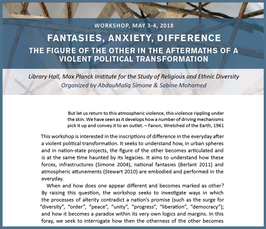"Fantasies, Anxiety, Difference. The Figure of the Other in the Aftermaths of a Violent Political Transformation"
Workshops, conferences 2018
- Beginn: 03.05.2018 09:30
- Ende: 04.05.2018 19:00
- Ort: MPI-MMG, Goettingen
- Raum: Library Hall

For more details please contact esser(at)mmg.mpg.de.
But let us return to this atmospheric violence, this violence rippling under the skin. We have seen as it develops how a number of driving mechanisms pick it up and convey it to an outlet. – Fanon, Wretched of the Earth, 1961
This workshop is interested in the inscriptions of difference in the everyday after a violent political transformation. It seeks to understand how, in urban spheres and in nation-state projects, the figure of the other becomes articulated and is at the same time haunted by its legacies. It aims to understand how these forces, infrastructures (Simone 2004), national fantasies (Berlant 2011) and atmospheric attunements (Stewart 2010) are embodied and performed in the everyday.
When and how does one appear different and becomes marked as other? By raising this question, the workshop seeks to investigate ways in which the processes of alterity contradict a nation’s promise (such as the surge for “diversity”, “order”, “peace”, “unity”, “progress”, “liberation”, “democracy”); and how it becomes a paradox within its very own logics and margins. In this foray, we seek to interrogate how then the otherness of the other becomes configurated. What are the foundations (erasures and counter discourses) and violent manifestations of these promised urban or national projects? Which forms of domination, time-spaces and images are mobilized to create these projects in order to encounter a violent legacy? How do attachments and affects emerge in the day-to-day life?
In the aftermath of spectacular violence, events are often inscribed as social suffering and trauma and pose the question how (after)life is constituted. This in turn raises the question of how these dangers are mastered, domesticated and reappear in different forms. Along this line, Veena Das (2006) invokes the theme of social suffering and violence by interrogating how the “recesses of the ordinary” have entered into everyday life. How does episodical communal or state violence point to an opening onto a surface of potential equality of possible interactions? A possibility, where pre-existent measures of difference do not specify the weight of mutual affecting? In ordinary life certain things and objects after violent episodes emerge as habitable and uninhabitable (Simone 2016, Stewart 2010). We aim to understand how to think about things, difference and violence in states of transition.
For as Yasmeen Arif (2016) argues, the politics of the power in and of life restitute the social as the plane of relationalities, as the expression of such power individuated into specific forms of embodiment that are sustained in that social. The social as a process of incessant association that drives the intensity of affect and undergirds life as a belief in commonality. Life is then something extrapolated to all forms through which people attempt to navigate their oscillating attachments to their experiences as individuals and collective identities. These are attachments that are always dislocated and interrupted, requiring negotiations that cannot be settled once and for all. How can certain forms of life withhold recognition or negate coming to life or to remain in the in-betweens of life and death?
Yet something that could not be anticipated and contained by the crisis of violence takes place, or rather disrupts the entirety of the place in which it occurs, not so much mirroring the catastrophic but more as a surging of things toward each other, not to suture the divides but to attain different moments of proximity. Therefore, in this intersection of obligation, disappointment, ressentiment, indifference, and affective communing, the social does not so much frame a context for inhabitation but amplifies the provisionality of any place where we would assume individual subjectivity to really “reside.” Responses to violence then often do further violence by not engaging that window, that opening, and rather seek to restore things to some stability, to rework the fractured relationalities in the very terms that preceded the episode.
Fanon described atmospheric violence as something
that is rippling under the skin, we want to follow this thread and think
about violence and difference in the everyday and through episodes.
This workshop attempts to scrutinize through thick ethnographic
explorations and theoretical contributions on states of exception,
states in transformations, states in ordinary crisis as well as the
production of (national) fantasies and processes of difference (that may
be fostered through gender, ethnic/race or religious marks).